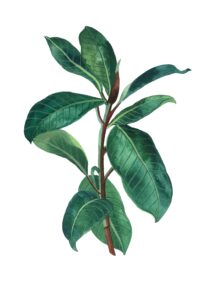 A Symbol of Confined Growth
A Symbol of Confined Growth
By Olivia Go (’24)
What could the rubber plant (Ficus elastica) possibly have to do with the patriarchy? Examining Sylvia Plath’s work, one is able to see that these plants, naturally deep-rooted and expansive, actually can shed light on the oppressive condition of the domestic space and the restrictive nature of womanhood in the 1950s.
Consider The Bell Jar, where Plath first mentions the rubber plant. Esther, the novel’s main character, sits in the office of Jay Cee, an editor and her internship supervisor at a famous women’s magazine. Esther fantasizes about Jay Cee’s life but doesn’t dream about the sacrifices she’s had to make. Esther doesn’t want to give up her dream of having a family, even though she aspires to having a successful career. The plants in Jay Cee’s office embody success for Esther. She imagines having an office like Jay Cee, with plants that someone else would maintain on her behalf (Plath 2005: 39):
I tried to imagine what it would be like if I were Ee Gee, the famous editor, in an office full of potted rubber plants and African violets my secretary had to water each morning.
Esther wants success but is wary of its costs. She’s confronted with different paths: homemaker or professional. Was Jay Cee’s choice “good”? Was it “bad”? Esther’s quandary is captured by the potted rubber plants sitting on the windowsill. Rubber plants seem to symbolize Esther herself. In their natural habitat, rubber plants are a sprawling species that develops buttresses to support its broadly spreading branches. Confined in pots, this common houseplant limits their growth and potential, a costly adaptation to its artificial surroundings (Plath 2005: 101):
I stared through the frieze of rubber-plant leaves in Jay Cee’s window to the blue sky beyond. A few stagey cloud puffs were traveling from right to left. I fixed my eyes on the largest cloud, as if, when it passed out of sight, I might have the good luck to pass with it.
Consider also Plath’s use of rubber plants is her 1962 poem, “Waking in Winter.” “Noiseless, on rubber wheels, on the way to the sea resort.” Later, she says, “The deathly guests had not been satisfied/ With the rooms, or the smiles, or the beautiful rubber plants” (Plath 2018: 151). Plath wrote this poem after she’d been hospitalized due to her appendectomy. The contrast between rubber wheels and plants is a commentary on the insulated peacefulness that’s created by hospitals. The outside world is bleak and overrun with rubber wheels while the hospital is equally bleak except decorated with rubber plants. There’s an effort to create a perfect space for healing, but it is an artificial serenity (see also Brain 2001).
As in The Bell Jar, the rubber plants in “Waking in Winter” are ornamental and contained in artificial settings. The rubber plant represents perceived success and joy. What looks outwardly appealing can be shallow and trapped by its surroundings. The glittering New York world that Esther strives to be a part of soon reveals itself to be hollow and dangerous. Even as a writer and observer, her access is limited by the fact of being a woman. In a July 1951 journal entry, Plath writes (Plath 2000: 77):
Yes, my consuming desire to mingle with road crews, sailors and soldiers, bar room regulars—to be a part of a scene, autonomous, listening, recording—all is spoiled by the fact that I am a girl, a female always in danger of assault and battery.
Plath wanted to spread her branches as far as they could go. However, like the rubber plant is trapped by its pot Plath was trapped by the confines of the society she lived in, including its ideas of how a woman should behave and be treated. The rubber plant is a symbol of success and of joy, but mostly of the costs and sacrifices it can demand.
Works Cited
Brain, Tracy. 2001. The Other Sylvia Plath. Harlow: Routledge.
Plath, Sylvia. 2000. The Unabridged Journals of Sylvia Plath. Edited by Karen V. Kukil. Unabridged edition. New York: Anchor.
———. 2005. The Bell Jar. Princeton, NJ: Harper Perennial Modern Classics.